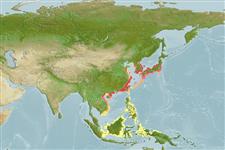Common names from other countries
Environment: milieu / climate zone / depth range / distribution range
Écologie
; saumâtre; profondeur 0 - 20 m (Ref. 8). Subtropical, preferred 24°C (Ref. 107945); 40°N - 5°S, 105°E - 141°E
Western Pacific. Subtropical to tropical.
Length at first maturity / Taille / Poids / Âge
Maturity: Lm ? range ? - ? cm Max length : 11.0 cm TL mâle / non sexé; (Ref. 8); 12.5 cm TL (female)
Maximum carapace length: 2.7 cm (male); 3.4 cm (female) (Ref. 8). Omnivorous (Ref. 81316). Feeds on crustaceans and mollusks (Ref. 114819).
Life cycle and mating behavior
Maturité | Reproduction | Frai | Œufs | Fécondité | Larves
Members of the order Decapoda are mostly gonochoric. Mating behavior: Precopulatory courtship ritual is common (through olfactory and tactile cues); usually indirect sperm transfer.
Holthuis, L.B. 1980. (Ref. 8)
Statut dans la liste rouge de l'IUCN (Ref. 130435)
statut CITES (Ref. 108899)
Not Evaluated
Not Evaluated
Utilisations par l'homme
Pêcheries: commercial
FAO - pêcheries: landings | FishSource | Sea Around Us
Outils
Sources Internet
Estimates based on models
Preferred temperature
(Ref.
115969): 14.8 - 26.5, mean 20.6 (based on 277 cells).
Résilience
Haut, temps minimum de doublement de population inférieur à 15 mois (K=0.96-1.22).
Vulnérabilité
Low vulnerability (10 of 100).
